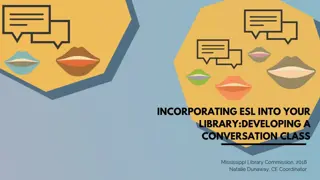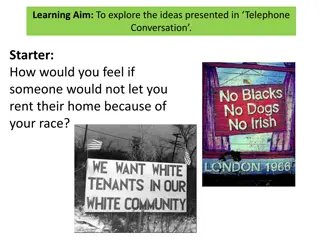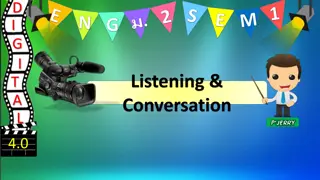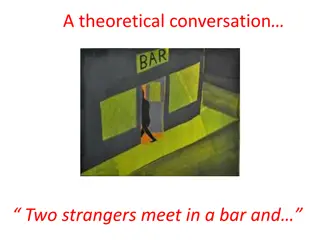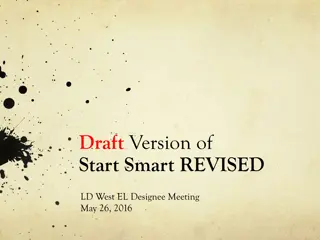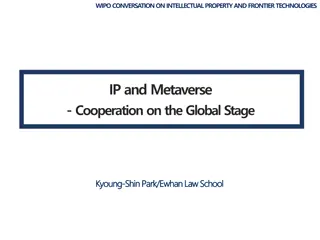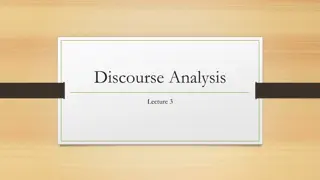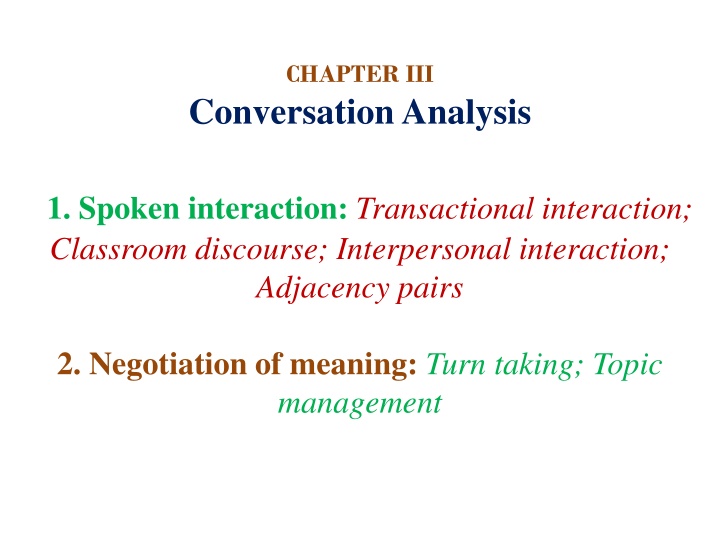
Conversation Analysis: Interaction, Politeness, Turn-taking
Explore the intricacies of Conversation Analysis (CA) focusing on spoken interaction, negotiation of meaning, and adjacency pairs. Delve into concepts like face politeness, turn-taking, and cultural influences on communication. Gain insights into the rules and dynamics of conversations for effective communication.
Download Presentation

Please find below an Image/Link to download the presentation.
The content on the website is provided AS IS for your information and personal use only. It may not be sold, licensed, or shared on other websites without obtaining consent from the author. If you encounter any issues during the download, it is possible that the publisher has removed the file from their server.
You are allowed to download the files provided on this website for personal or commercial use, subject to the condition that they are used lawfully. All files are the property of their respective owners.
The content on the website is provided AS IS for your information and personal use only. It may not be sold, licensed, or shared on other websites without obtaining consent from the author.
E N D
Presentation Transcript
CHAPTER III Conversation Analysis 1. Spoken interaction: Transactional interaction; Classroom discourse; Interpersonal interaction; Adjacency pairs 2. Negotiation of meaning: Turn taking; Topic management
CONVERSATION ANALYSIS (CA) * Conversation is an activity in which 2 or more people take turns at speaking. * The rule of conversation: A stops until B has finished. * CA is an object of investigation, rule-governed talk; * Analysis of conversation produced a number of concepts: face politeness, turn-taking, adjacency pair.
* Face politeness: In sociolinguistics & conversation analysis, politeness are speech acts that express concern for others & minimize threats to self-esteem ("face") in particular social contexts. * Face politeness consists of Positive & Negative Politeness Strategies (Brown & Levinson. 1987). + Positive politeness strategies: claim a common ground, give/ask reasons, include speaker & hearer in the activity, intensify hearer s interest, give gifts to hearer, be optimistic, use in-group identity markers, joke, seek agreements, offer/promise, notice & attend to hearer s interests & needs & presuppose. + Negative politeness strategies include: be indirect, hedging, minimize imposition, be apologetic, give deference, impersonalize & using a general rule.
Cooperation & Culture in turn-taking of conversation * Knowing when it is acceptable or obligatory to take a turn in conversation is essential to the cooperative development of discourse. Factors as knowing how to recognize appropriate turn-exchange points & knowing how long the pauses between turns should be. It is also important to know how (and if) one may talk while someone else is talking - that is if the conversational overlap is allowed. * Cultural differences in matters of turn-taking can lead to conversational breakdown, misinterpretation of intentions, & interpersonal intergroup conflict.
Adjacency pair * Adjacency pair: 2 parts of exchange where the first speaker initiates the first of the pair & having been the hearer responds with the second part of the pair. > In conversation analysis, an adjacency pair is a two-part exchange in which the second utterance is functionally dependent on the first, as exhibited in conventional greetings, invitations, & requests. It is also known as the concept of nextness. Each pair is spoken by a different person.
* Adjacency pairs include such exchanges as question/answer; complaint/denial; offer/accept; request/grant; compliment/rejection; challenge/rejection, instruct/receipt. Adjacency pairs typically have three characteristics: Consist of two utterances; The utterances are adjacent, that is the first immediately follows the second; Different speakers produce each utterance
Utterance function Expected response greeting >>>>> greeting congratulation >>>> thanks apology >>>> acceptance infor >> acknowledgement leave-taking >> leave-taking
Functions of language 2 main functions: Transactional & Interactional * Transactional function: Conveying information from person to person (expressing the content of what we say or speak) > MESSAGE ORIENTED (proper message) Transaction: Representative, Referential, Ideational, Descriptive Written language is for transactional purposes
* Representatives: commit a speaker to the truth of an expressed proposition/ judge the truth value Paradigm cases: Asserting, Stating, Concluding, Boasting, Describing, Suggesting (with modal verbs) Ex. - I am a great singer. (boasting) - Bill was an accountant.(stating)
A reference transaction: an information contact which involves the knowledge, use, recommendations, interpretation, or instruction in the use of one or more information sources.
* Interactional function/Interpersonal Interaction > A communication process that involves the exchange of information, feelings and meaning by means of verbal and non-verbal messages, between two or more persons. > Conveying personal attitudes or establishing & maintaining social relations/rapport. * Interaction: expressive, emotive, interpersonal, socio-expressive Spoken language is primarily interactional purposes
Expressive interaction: a branch of human interaction that focuses on expressive communication between actors performing in a particular context (e.g., culture, environment). Expression thereby refers to a quality of communication that is capable of evoking responses in return * 3 domains of expressive interaction- companionship, sexual/evocative expression, and supportive communication in predicting relationship satisfaction & commitment.
The emotive/emotional interaction mechanism describes the way emotions affect each other. Emotions can have an augmenting or diminishing effect over other emotions. When an emotion is excited, this one could affect another emotion behavior, and this affection is what we call emotional interaction.
Types of Emotions According to Paul Eckman: six universal emotions: Happiness: a pleasant emotion where people feel a greater sense of well-being& satisfaction. Sadness: sadness include grief, hopelessness, and disappointment. Fear: Fear can increase your heart rate, cause racing thoughts, or trigger the fight-or-flight response. It can be a reaction to actual threats or perceived threats. Disgust: Disgust can be triggered by a physical thing, such as rotting food, blood, or poor hygiene. Moral disgust may occur when someone sees another person doing something they find immoral or distasteful. Anger:Anger can be expressed with facial expressions like frowning, yelling, or violent behavior. Surprise: Surprise can be pleasant or unpleasant. Surprise, like fear, can trigger the fight-or-flight response.
Social interaction: The process by which we act & react to those around us. In a nutshell, social interaction includes those acts people perform toward each other & the responses they give in return. Social interactions include a large number of behaviors. In sociology, interaction is divided into 5 categories: exchange, competition, cooperation, conflict and coercion.
Interpersonal interaction: a communication process that involves the exchange of information, feelings & meaning by means of verbal & non- verbal messages, between two or more persons. * Four types of interpersonal interaction - oral, verbal, nonverbal, & listening
2. Negotiation of meaning * Turn-taking, Adjacency pair are 2 most important mechanisms the object of intensive investigation Turn-taking begins when an interlocutor starts solo talking & ends when a different interlocutor starts solo talking. > Turn-taking occurs in a conversation when one person listens while the other person speaks. As a conversation progresses, the listener & speaker roles are exchanged back & forth (a circle of discussion).
Topic management refers to the related topic subjects discussed by the speakers during the turn taking. * Topic Management are usually relevant to the current topic or will attempt to initiate new topics. In formal situations there may be a predetermined topic or set of topics that is discussed in a systematic way. (e.g. a meeting, interview or lecture). In informal interactions, conversations will drift from topic to topic. The main topic (the reason for the exchange) may not come first.
* Topic plays a very important role in practicing the speaking skill in any learned language because one cannot control a communication without managing the related topic. Topic introduction, shifting, & maintenance are essential elements for providing conversational coherence & continuity. In doing the conversation, how the speaker maintain the topic is related to the social culture where the speaker appears. The speaker should not talk about topic thought as a taboo by the society. There is an effort to maintain the topic so it won t change easily before another speaker follows the previous topic. > Topic management also includes an awareness of how speakers deal with changes in a topic, how they maintain a topic, & how they repair the interaction when a misunderstanding occurs.
Classroom Discourse * Definition: It refers to the language that teachers & students use to communicate with each other in the classroom. (Classroom discourse is an interaction between teachers & learners & between learners & learners.) * The nature of classroom discourse: brings clarity, its distinctiveness in the speech. During interaction teachers have the scope to identify the talent, intelligence & excellence of the pupils. * Types of DA: 3 patterns: + Silent (the teacher talks almost all the time & asks only an occasional question); + Controlled; + Active (the teacher facilitates while the students talk primarily to each other).
CONTEXT * In semiotics, linguistics, sociology & anthropology, context refers to those objects or entities which surround a focal event. * In a communicative event Context is "a frame that surrounds the event & provides resources for its appropriate interpretation".
FEATURES OF CONTEXT Context embraces the following categories: * The relevant features of participants: persons & personalities (verbal/oral action or non-verbal action of participants). * The relevant of objects * The effect of the verbal action
Hymes identifies the following listing of context features: Addressor (speaker or writer) & addressee (hearer or listener/decoder of utterance); Audience (unintended addressees); Topic (range of language); Setting (place, time, posture, gesture, facial expression; Channel (how the contact between participants: speech, writing, signing, signal); Code (kind of language, style of language); Message-form (chat, debate, sermon, fairytale, love letter, lecture, radio talk, play ); Event (nature of communication, genre: opening speech, welcoming speech, papers); Key (evaluation); Purpose (outcome the participant want to happen).
Principle of Local interpretation The extend of the context within which the hearer will interpret where they are (speaker & hearer)/the local setting. Ex. A man & a woman sitting in the living room the man s bored, goes to the window, looks out the window and goes out to a club, has a drink, talks to the barman. > (Hearer assumes that the entities(man &woman) will remain & local setting will stay constant. The hearer interpreted that the window is of & in the living room, the club is near to the living room)
PRINCIPLE OF ANALOGY An Analogy is a relation of similarity between two or more things, so that an inference (reasoning from premise to conclusion) is drawn on the basis of that similarity.
The principle of analogy enables the hearer or listener to interpret discourse in light of his past experience & background knowledge. > When the hearer encounters a new situation he selects from his memory a type of experience he has generalized before & relates it to his background knowledge in order to interpret >> Analogy with previous similar discourse.
Revision of Chapter III 1. What is conversation and conversation analysis? The characteristics of conversation analysis? 2. What are Transactional & Interactional, their types? 3. What are interpersonal interaction, Adjacency, Turn-taking, Topic management and Classroom discourse?








